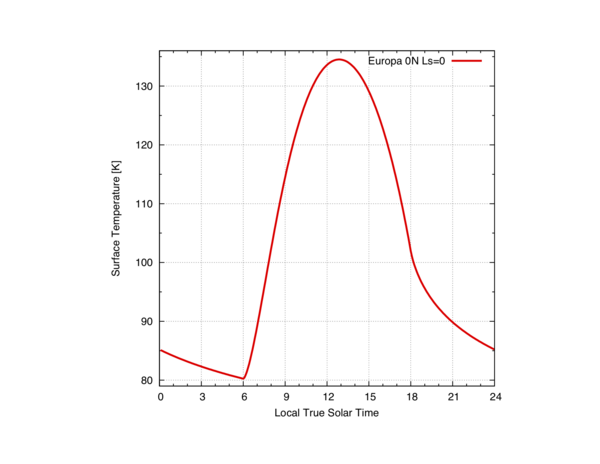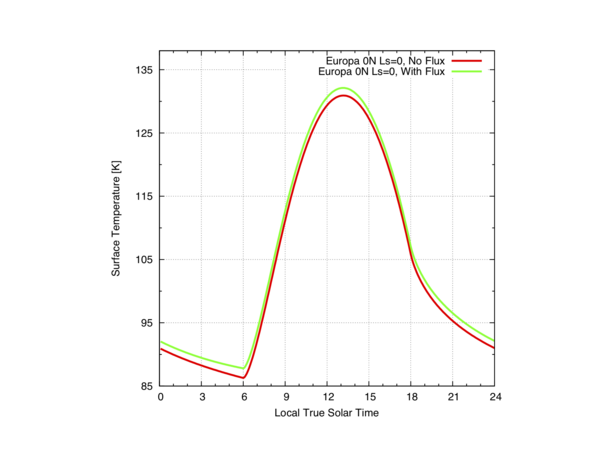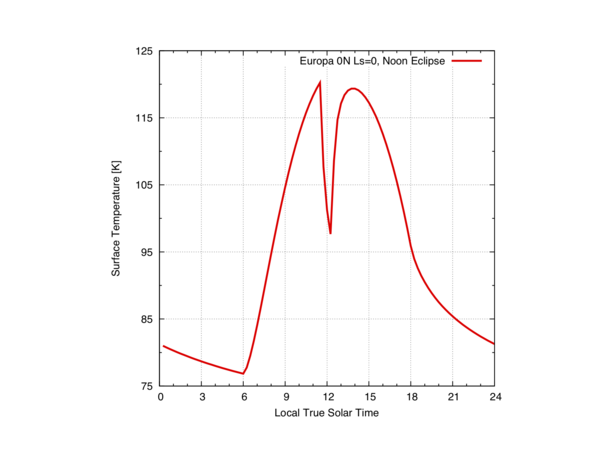KRC for Europa
Notes
Water ice is the default material for Europa (Mat = "H2O"), and T_user = 100 (temperature at which the inertia is defined). TI_CO = 1200 (transition TI from particulated behavior to continuous behavior).
Some parameters are set to realistic values by default, including:
- Mat1 = "H2O" which assigns water ice Cp, Density, and Conductivity properties
- Mat2 = "H2O" which assigns water ice Cp, Density, and Conductivity properties
- ALBEDO = 0.67
- PTOTAL = 0 which eliminates the atmosphere (ELEV, TAU, etc. unused)
When running the DaVinci interface, default Mars atmospheric values might be printed on the screen but not effectively used (PTOTAL = 0.)
Command Line Examples
Basic surface temperatures for Europa:
dv> OUT = krc(lat = 0, INERTIA = 45., body="Jupiter,Europa", bodytype = "minor", ALBEDO = .55, LKofT = "F")
 Example of simple diurnal temperature curve
Example of simple diurnal temperature curve
labelxy("LTST","Temperature [K]")
plot(OUT.tsurf[,1,1],xaxis=OUT.time,"45 Kieffer, No Flux",w=2,color=2)
To include the visible and thermal infrared flux from Jupiter, three approaches are possible:
1: Use default built-in parameters, set PFlux = "T", and Lon_Hr
- Lon_Hr [0-24] is the surface longitude relative to the sub-Jupiter point, expressed in hours.
- When Lon_Hr < 6, the surface point is on the Antijovian hemisphere => No flux contributed.
- When 6 < Lon_Hr < 18, the surface point is on the subjoin hemisphere => Flux is contributed (max at Lon_Hr = 12.).
- When Lon_Hr > 18, the surface point is on the Antijovian hemisphere => No flux contributed.
dv> OUT = krc(lat = 0., INERTIA = 70., body = "Jupiter,Europa", bodytype = "minor", ALBEDO = 0.55, PFlux = "T", Lon_Hr = 12., LKofT = "F")
2: Provide values for all the necessary input parameters, and set PFlux = "T" (Default provided for common bodies)
- BT_Avg : Average Brightness Temperature [K]
- BT_Min : Min Brightness Temperature, if diurnal cycle [K]
- BT_Max : Max Brightness Temperature [K]
- Dis_AU : Distance from Sun in AU
- Geom_alb : Geometric Albedo [1]
- Mut_Period : Mutual Period [?]
- Orb_Radius : Orbiting Radius [km]
- Radius : Radius of the Obiting body [km]
- Lon_Hr : Longitude Hour of the surface point (see above)
dv> OUT = krc(lat = 0., INERTIA = 70., body = "Jupiter,Europa", bodytype = "minor", ALBEDO = 0.55, PFlux = "T", BT_Avg = 127., BT_Min = 127., BT_Max = 127., Dis_AU = 5.203, Geom_alb = 0.52, Mut_Period = 3.55, Orb_Radius = 670900, Radius = 670900, Lon_Hr = 12., LKofT = "F")
3: Provide Visible and IR flux tables vs. LTST, and set PFlux = "T"
- The interface fits sin functions through the table values, and extracts parameters required by KRC (amplitude, phase, etc.). For Europa, this is not the preferred option.
- IR: A 2 x n x 1 array with IR flux (1st col.) vs. LTST (2nd col.)
- Vis: A 2 x n x 1 array with Vis flux (1st col.) vs. LTST (2nd col.)
dv> OUT = krc(lat = 0., INERTIA = 70., body = "Jupiter,Europa", bodytype = "minor", ALBEDO = 0.55, PFlux = "T", Lon_Hr = 12., LKofT = "F")
 Comparison between simple diurnal temperature curves (with vs. without Jupiter flux)
Comparison between simple diurnal temperature curves (with vs. without Jupiter flux)
dv > OUT_2 = krc(lat = 0, INERTIA = 70., body = "Jupiter,Europa", bodytype = "minor", ALBEDO = .55, LKofT="F")
dv > OUT_3 = krc(lat = 0., INERTIA = 70., body = "Jupiter,Europa", bodytype = "minor", ALBEDO = 0.55, PFlux = "T", Lon_Hr = 12., LKofT = "F")
dv > labelxy("LTST","Temperature [K]")
dv > plot(OUT_2.tsurf[,1,1], xaxis = OUT_2.time, "70 Kieffer, No Flux", w = 2, color = 2, OUT_3.tsurf[,1,1], xaxis = OUT_3.time, "70 Kieffer, With Flux", w = 2, color = 3)
To include an Eclipse by Jupiter, set Eclipse = "T" and specify the following parameters:
- Eclipse = "T" forces an eclipse (Default = "F")
- body = "Jupiter,Europa"
- Eclipser = "Jupiter_Jupiter" Eclipser name, for Example "Jupiter_Jupiter" or "Mars_Phobos"
- Eclipse_Style = 1 because eclipses are assumed to occur daily; see dedicated Eclipse Section [Build Link Here]
- Ecl_Cent_Hr: Eclipse central hour [subjovian point => =12.; Antijovian point => =0.]
- Bias = 0.0: Eclipse Bias (0 => perfect alignement; 1 => partial eclipse); see dedicated Eclipse Section [Build Link Here]
- Date: ???
dv> OUT = krc(lat = 0., INERTIA = 045., N1 = 32, body = "Jupiter,Europa", bodytype = "minor", N24 = 96, Eclipse = "T", Eclipser="Jupiter_Jupiter", Ecl_Cent_Hr = 12., Bias = 0., Eclipse_Style = 1., Date = 5000.)
 Example of Europa diurnal curve with Jupiter Eclipse centered at Noon
Example of Europa diurnal curve with Jupiter Eclipse centered at Noon
labelxy("LTST","Temperature [K]","45 Kieffer, Eclipse centered at Noon")
plot(OUT.tsurf[,1,1],xaxis=OUT.time,"Noon Eclipse")